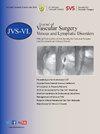接受超显微外科淋巴管-静脉吻合术的肢体淋巴水肿患者术前成像方法的一致性。
IF 2.8
2区 医学
Q2 PERIPHERAL VASCULAR DISEASE
Journal of vascular surgery. Venous and lymphatic disorders
Pub Date : 2024-04-15
DOI:10.1016/j.jvsv.2024.101891
引用次数: 0
摘要
目的上皮细胞手术淋巴管-静脉吻合术(LVA)因其微创、高效而被越来越多的人视为肢体淋巴水肿的一线治疗方法。淋巴管造影(Lymphoscintigraphy)和吲哚菁绿(ICG)淋巴造影(indocyanine green, ICG)是两种最常用的诊断成像检查方法,用于确定肢体淋巴水肿患者的适应症并制定手术计划。在一小部分患者中,这两种成像工具之间的信息可能不一致,在一种检查中显示不同的解剖引流路径,或没有引流和真皮回流,而在另一种检查中显示有效的引流路径。本研究的目的是检查浅表系统淋巴管造影和 ICG 淋巴造影之间可能存在差异的类型,并描述出现此类差异的患者在 LVA 后的手术结果。方法我们回顾性地审查了 2015 年 7 月至 2023 年 7 月期间因上肢或下肢淋巴水肿而接受 LVA 的所有患者的数据。从这一系列数据中,我们发现了一组淋巴手术前淋巴窥镜成像和ICG淋巴造影成像结果不一致的患者。不一致的结果用 "模式不一致 "和 "路径不一致 "来描述。手术结果以术后肢体平均周长的变化来衡量。术前和术后肢体测量值之间的变化采用学生 t 检验进行分析。结果共有28例肢体淋巴水肿患者的术前浅表系统淋巴管造影与ICG淋巴造影结果不一致。在这些患者中,14 例出现模式不一致,13 例出现路径不一致,1 例同时出现模式和路径不一致。结论 在对肢体淋巴水肿患者进行术前研究时,淋巴管造影和 ICG 淋巴造影的信息不一致的情况虽然罕见,但却有可能发生。然而,我们的研究结果表明,这种现象与超微创肢体淋巴水肿手术的结果无关。本文章由计算机程序翻译,如有差异,请以英文原文为准。
Concordance between preoperative imaging methods in patients with limb lymphedema undergoing supermicrosurgical lymphaticovenular anastomosis
Objective
Supermicrosurgical lymphaticovenular anastomosis (LVA) is increasingly being recognized as a first-line treatment of limb lymphedema because it is minimally invasive and highly effective. Lymphoscintigraphy and indocyanine green (ICG) lymphography are the two most commonly performed diagnostic imaging examinations to establish the indication and plan the procedure for patients affected by limb lymphedema. In a small group of patients, the information between these two imaging tools can be discordant, showing different anatomical drainage pathways or the absence of drainage and dermal backflow in one examination and valid drainage pathways in the other. The purpose of this study is to examine the types of possible discrepancies between lymphoscintigraphy of the superficial system and ICG lymphography and to describe the surgical outcomes after LVA for patients presenting with such discrepancies.
Methods
We retrospectively reviewed the data of all patients who underwent LVA for upper or lower limb lymphedema between July 2015 and July 2023. From this series, we identified a group of patients with nonconcordant imaging results from lymphoscintigraphy and ICG lymphography before lymphatic surgery. Nonconcordant findings were described in terms of “pattern discordance” and “pathway discordance.” The surgical outcome was measured by the change in the mean circumference of the limb after surgery. The changes between the preoperative and postoperative limb measures were analyzed using the Student t test. P values < .05 were considered significant.
Results
A total of 28 patients with limb lymphedema exhibited inconsistencies between preoperative lymphoscintigraphy of the superficial system and ICG lymphography. Among these patients, 14 experienced pattern discordance, 13 had pathway discordance, and 1 patient had both. After LVA, we observed a significant reduction in the average circumference of the affected limb in the analyzed group.
Conclusions
The discrepancy in the information between lymphoscintigraphy and ICG lymphography in the preoperative study of patients affected by limb lymphedema is rare but possible. This phenomenon is still not fully explained; however, our results suggest that it does not correlate with the outcome of supermicrosurgical LVAs.
求助全文
通过发布文献求助,成功后即可免费获取论文全文。
去求助
来源期刊

Journal of vascular surgery. Venous and lymphatic disorders
SURGERYPERIPHERAL VASCULAR DISEASE&n-PERIPHERAL VASCULAR DISEASE
CiteScore
6.30
自引率
18.80%
发文量
328
审稿时长
71 days
期刊介绍:
Journal of Vascular Surgery: Venous and Lymphatic Disorders is one of a series of specialist journals launched by the Journal of Vascular Surgery. It aims to be the premier international Journal of medical, endovascular and surgical management of venous and lymphatic disorders. It publishes high quality clinical, research, case reports, techniques, and practice manuscripts related to all aspects of venous and lymphatic disorders, including malformations and wound care, with an emphasis on the practicing clinician. The journal seeks to provide novel and timely information to vascular surgeons, interventionalists, phlebologists, wound care specialists, and allied health professionals who treat patients presenting with vascular and lymphatic disorders. As the official publication of The Society for Vascular Surgery and the American Venous Forum, the Journal will publish, after peer review, selected papers presented at the annual meeting of these organizations and affiliated vascular societies, as well as original articles from members and non-members.
 求助内容:
求助内容: 应助结果提醒方式:
应助结果提醒方式:


